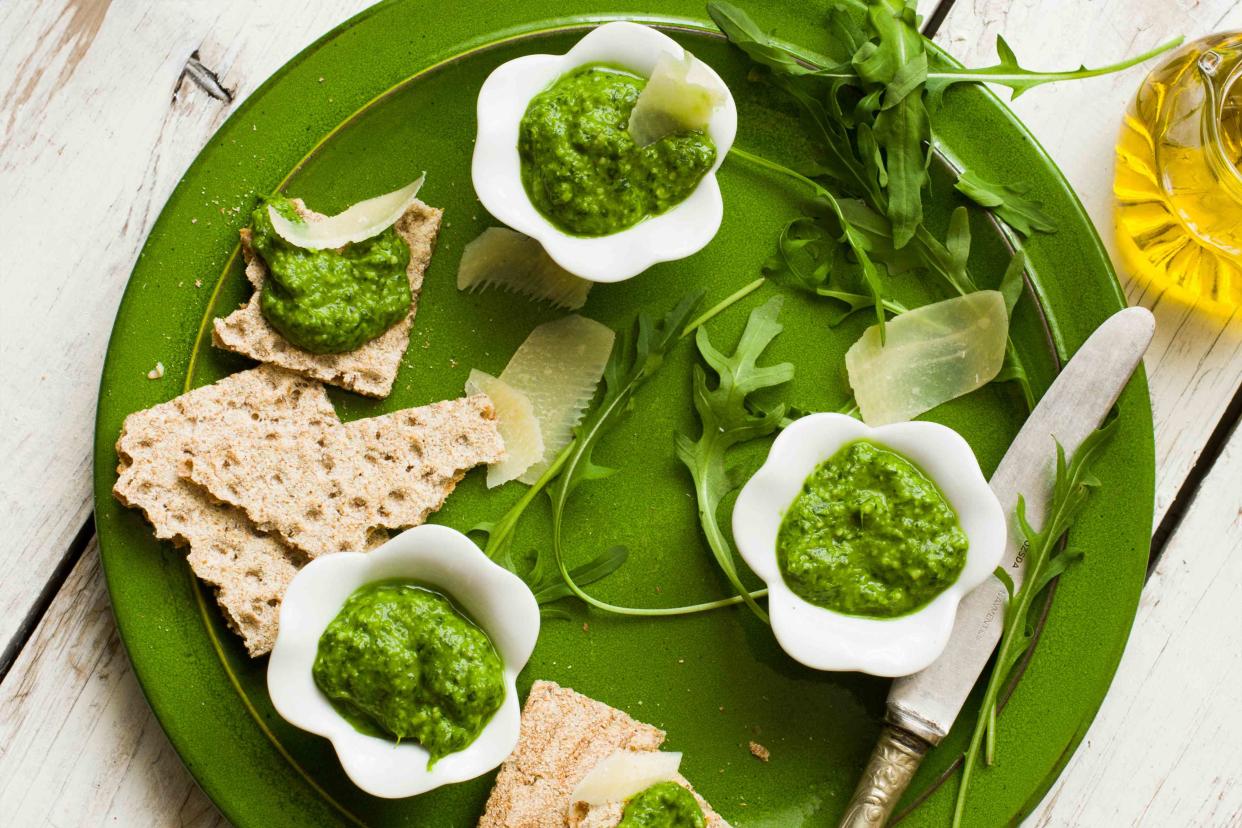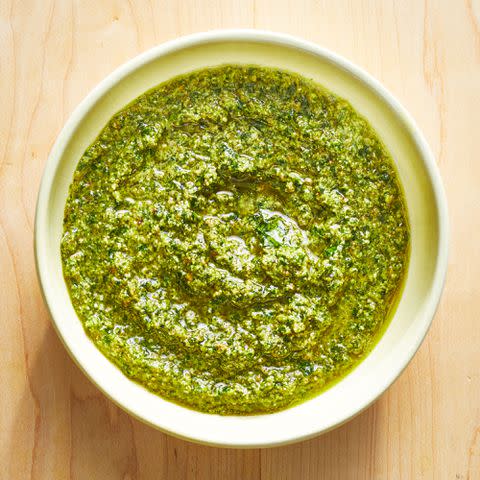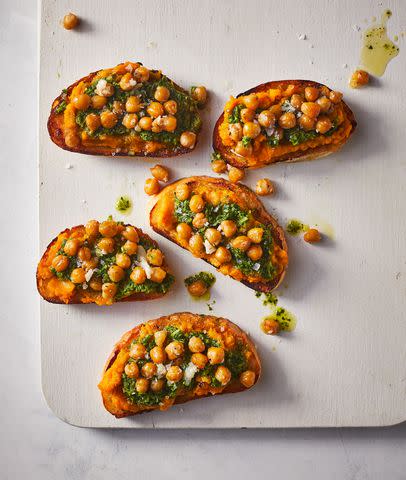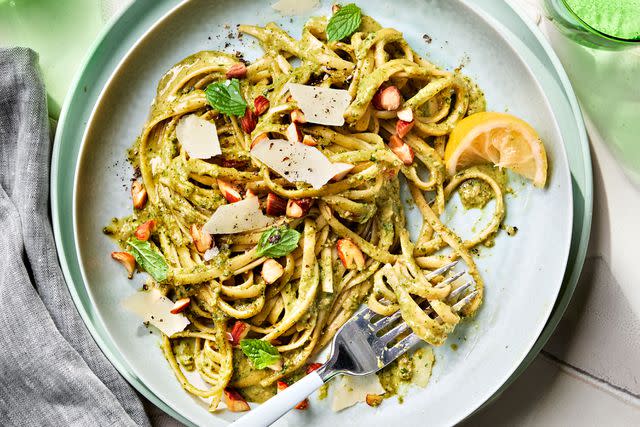What Is Pesto? It's the Cheesy, Healthy Condiment You Need to Use More Often
Vibrant in color and flavor, pesto is the ultimate meal enhancer.

Adél Békefi/Getty Images
Pastas and pizzas don’t need much help in the flavor department, but when you add pesto, amazing things can happen. But what is pesto, exactly? The bright green, herby sauce calls for just a few simple ingredients, and unlike some tomato-based sauces that need to simmer for hours, it’s ready in mere minutes. Given its popularity, pesto is also sold at most grocery stores. Whether you make or buy pesto, it can liven up many a dish. It’s also versatile and packed with nutrients. Spread it on sandwiches, use it as a marinade for meat, or toss your vegetables in it. However you like to enjoy pesto, it’s a delicious source of vitamins, minerals, antioxidants, and healthy fats. Aside from it being delicious and nutritious, here’s what else you need to know about pesto.
What Is Pesto?
Pesto is an Italian sauce that’s bright green and made from combining basil leaves, pine nuts, garlic, olive oil, salt, and Parmigiano-Reggiano (aka Parmesan) cheese. A hard cheese is always called for, and while Parmesan is most commonly used, other cheeses like pecorino sardo can also sub in. Pesto is thick like a paste, making it perfect for coating pasta noodles, and it’s full of flavor.
Related: A List of 12 Essential Condiments You Should Have at All Times
Having been around for hundreds of years, pesto is nothing new, though it remains as relevant today as it was when it was first created. Variations of pesto date back to 16th century Italy. However, pesto has gone through several iterations over the centuries. The variation most similar to today’s pesto likely originated in the 19th century. Specifically, the city of Genoa, Italy, is credited with creating pesto.
What Is Pesto Made Of?
Like any sauce or condiment, there are many ways to make pesto. From substituting ingredients to using various amounts of its core components, no two pestos taste the same. However, traditional pesto is made with the following ingredients:
Basil leaves
Pine nuts
Garlic
Olive oil
Parmesan cheese
Pesto is considered a healthier sauce option because of its nutritious ingredients list. It’s known for being a rich source of healthy fats, such as omega-3 fatty acids, thanks to pine nuts and olive oil. It’s also rich in micronutrients, especially antioxidants, from the handfuls of basil leaves and crushed garlic. Plus, the most common type of cheese used in pesto—Parmesan cheese—is high in protein and naturally free from lactose, so it tends to be gentler on the stomach.
If you’re wondering what pesto tastes like, it’s a medley of bright, herby flavors from the basil, but with a richness from the nuts, cheese, and oil. And, of course, it has strong notes of garlic.
Related: 4 Salsa Styles and How To Make Them
How to Use Pesto
Like marinara sauce, there are hundreds—if not thousands—of ways to use pesto. Its most popular applications include pasta and pizza. You can use pesto as a pasta sauce on plain noodles, but for seasoned home chefs, it can elevate comfort dinners like lasagna or tortellini. While pesto can theoretically pair with any pasta shape, it works best with longer and more intricate noodles, such as fusilli, bucatini, and fettuccine.
Pesto also makes for a fierce rival to red sauce on pizza. Swap out the red sauce for a dollop of pesto for a more savory pie, adding sophisticated toppings like sun-dried tomatoes, capers, arugula, anchovies, and olives.
Other ways to use pesto include spreading it on toast or sandwich bread, incorporating it into casseroles, and baking it into savory pastries. It’s also the perfect base for dips, salad dressings, and marinades. Yes, pesto tends to pair best with carbohydrate-heavy meals like pizzas and pastas, but it also uniquely complements chicken and pork chops.
Pesto Recipes
Now that you know all there is to know about pesto, check out these pesto recipes!
Superfood Pesto

If you’re determined to make pesto at home, this pesto recipe is perfect for beginners. Simply dump all of the ingredients into a food processor and pulse until it’s a paste-like consistency. This variation of pesto is also perfect for people with food allergies because it’s nut-free. Instead of pine nuts, it calls for a trio of seeds—sunflower, hemp, and flax, to be exact.
Garlic Toast With Squash, Pesto, and Olive Oil-Braised Chickpeas

With sources of carbohydrates, protein, and healthy fats, this pesto toast recipe makes for a balanced meal. It’s got thick slices of bread topped with pesto for flavor, and squash and chickpeas for nutrients. If you’re into savory breakfasts, this is one that starts off your day with a serving of veggies, but thanks to the pesto smear, you won’t even notice them.
Related: 53 Delicious Squash Recipes to Cook in Any Season
Linguine With Broccoli Mint Pesto

Greg DuPree
You’ll be hard pressed to name a better duo than pesto and pasta, and this linguine recipe is the perfect example of why. It also teaches you how to make homemade pesto, albeit an almond-based one. You’ll pulverize broccoli into the freshly made pesto, which is excellent for sneaking veggies into your kids’ dinners. Toss the pasta in the sauce, and voila! You’ve got an impressive-looking (and tasting) meal that came together in 30 minutes.
For more Real Simple news, make sure to sign up for our newsletter!
Read the original article on Real Simple.






